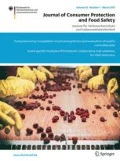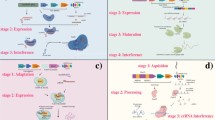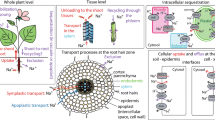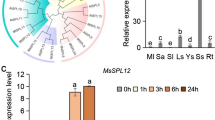Abstract
The recent advances in genome-wide transcriptome analysis have enabled researchers to identify new genes and manipulate the genome through novel genetic engineering methods to improve plant tolerance to different stresses. We conducted a genome-wide transcriptome analysis to determine tomato genes affecting the salt stress response. The results showed that among the 5784 genes that were responsive to salt stress, 103 genes (1.8%) encode transcription factors, of which 69 (1.2%) were upregulated and 34 (0.6%) were downregulated. The largest group of genes upregulated in response to salt stress (17 genes) is related to the ethylene response transcription factors (ERF) family. Specifically, it was found that the gene JERF1, encoding ERF in tomato, is upregulated in response to salt stress. In the present study we developed a new Agrobacterium-mediated transformation method to deliver the JERF1 gene to mature wheat embryos. It was investigated whether the factors vacuum infiltration, Agrobacterium cell density (OD600 1.0 and its dilutions 1:20, 2:20 and 3:20), the acetosyringone concentration (0, 200 and 400 μM) and the interaction between these factors affect transformation. To this end, Agrobacterium carrying pGWB14-JERF1 was injected into soaked wheat seeds, and T0 transgenic plants were obtained in the greenhouse. Molecular analysis of T0 plants was performed. The highest transformation efficiency was obtained under vacuum infiltration, 200 μM acetosyringone and 1:20 dilution. Notably, we used the in planta transformation method to overcome some of the problems of traditional wheat transformation methods e.g., sterile conditions, recalcitrant regeneration, time-constraints and somaclonal variations.




Similar content being viewed by others
Notes
http://www.affymetrix.com. Accessed February 2018.
http://bioinfo.bti.cornell.edu/cgi-bin/itak/index.cgi. Accessed March 2018.
http://plntfdb.bio.uni-potsdam.de/v3.0/). Accessed March 2018.
http://bioinfogp.cnb.csic.es/tools/venny/). Accessed March 2018.
References
Amoah BK, Wu H, Sparks C, Jones HD (2001) Factors influencing Agrobacterium-mediated transient expression of uidA in wheat inflorescence tissue. J Exp Bot 52(358):1135–1142. https://doi.org/10.1093/jexbot/52.358.1135
Ashrafi-Dehkordi E, Alemzadeh A, Tanaka N (2018a) Agrobacterium-mediated transformation of ovary of bread wheat (Triticum aestivum L.) with a gene encoding a tomato ERF protein. Plant Cell Biotechnol Mol Biol 19(1 & 2):24–33
Ashrafi-Dehkordi E, Alemzadeh A, Tanaka N, Razi H (2018b) Meta-analysis of transcriptomic responses to biotic and abiotic stress in tomato. PeerJ 6:e4631. https://doi.org/10.7717/peerj.4631
Bakshi S, Sadhukhan A, Mishra S, Sahoo L (2011) Improved Agrobacterium-mediated transformation of cowpea via sonication and vacuum infiltration. Plant Cell Rep 30(12):2281–2292. https://doi.org/10.1007/s00299-011-1133-8
Chakrabarty R, Viswakarma N, Bhat SR, Kirti PB, Singh BD, Chopra VL (2002) Agrobacterium-mediated transformation of cauliflower: optimization of protocol and development of Bt-transgenic cauliflower. J Biosci 27(5):495–502. https://doi.org/10.1007/BF02705046
Cheng M, Fry JE, Pang S, Zhou H, Hironaka CM, Duncan DR, Conner TW, Wan Y (1997) Genetic transformation of wheat mediated by Agrobacterium tumefaciens. Plant Physiol 115(3):971–980. https://doi.org/10.1104/pp.115.3.971
Danphitsanuparn P, Boonsnongcheep P, Boriboonkaset T, Chintapakorn Y, Prathanturarug S (2012) Effects of Agrobacterium rhizogenes strains and other parameters on production of isoflavonoids in hairy roots of Pueraria candollei Grah. ex Benth. var. candollei. Plant Cell Tissue Organ Cult 111:315–322. https://doi.org/10.1007/s11240-012-0196-8
de Oliveira MLP, Febres VJ, Costa MGC, Moore GA, Otoni WC (2009) High-efficiency Agrobacterium-mediated transformation of citrus via sonication and vacuum infiltration. Plant Cell Rep 28(3):387–395. https://doi.org/10.1007/s00299-008-0646-2
Feldmann KA (1987) David Marks M Agrobacterium-mediated transformation of germinating seeds of Arabidopsis thaliana: a non-tissue culture approach. Mol Gen Genet 208(1):1–9. https://doi.org/10.1007/BF00330414
Hiei Y, Komari T, Kubo T (1997) Transformation of rice mediated by Agrobacterium tumefaciens. Plant Mol Biol 35(1–2):205–218
Himmelbach A, Zierold U, Hensel G, Riechen J, Douchkov D, Schweizer P, Kumlehn J (2007) A set of modular binary vectors for transformation of cereals. Plant Physiol 145(4):1192–1200. https://doi.org/10.1104/pp.107.111575
Jones HD, Doherty A, Wu H (2005) Review of methodologies and a protocol for the Agrobacterium-mediated transformation of wheat. Plant Methods 1(1):5–14. https://doi.org/10.1186/1746-4811-1-5
Keshamma E, Rohini S, Rao KS, Madhusudhan B, Kumar MU (2008) Tissue culture-independent in planta transformation strategy: an Agrobacterium tumefaciens-mediated gene transfer method to overcome recalcitrance in cotton (Gossypium hirsutum L.). J Cotton Sci 12:264–272
Koetle MJ, Finnie JF, Balázs E, Van Staden J (2015) A review on factors affecting the Agrobacterium-mediated genetic transformation in ornamental monocotyledonous geophytes. S Afr J Bot 98:37–44
Leelavathi S, Sunnichan VG, Kumria R, Vijaykanth GP, Bhatnagar RK, Reddy VS (2004) A simple and rapid Agrobacterium-mediated transformation protocol for cotton (Gossypium hirsutum L): embryogenic calli as a source to generate large numbers of transgenic plants. Plant Cell Rep. 22(7):465–470. https://doi.org/10.1007/s00299-003-0710-x
Li S, Zhao DG, Wu YJ, Tian XE (2009) A simplified seed transformation method for obtaining transgenic Brassica napus plants. Agric Sci China 8(6):658–663. https://doi.org/10.1016/S1671-2927(08)60261-8
Lin J, Zhou B, Yang Y, Mei J, Zhao X, Guo X, Huang X, Tang D, Liu X (2009) Piercing and vacuum infiltration of the mature embryo: a simplified method for Agrobacterium-mediated transformation of Indica rice. Plant Cell Rep 28(7):1065–1074. https://doi.org/10.1007/s00299-009-0706-2
Liu Z, Park BJ, Kanno A, Kameya T (2005) The novel use of a combination of sonication and vacuum infiltration in Agrobacterium-mediated transformation of kidney bean (Phaseolus vulgaris L.) with lea gene. Mol Breed 16(189):189. https://doi.org/10.1007/s11032-005-6616-2
Mayavan S, Subramanyam K, Jaganath B, Sathish D, Manickavasagam M, Ganapathi A (2015) Agrobacterium-mediated in planta genetic transformation of sugarcane setts. Plant Cell Rep 34(10):1835–1848. https://doi.org/10.1007/s00299-015-1831-8
Miao MM, Xu R, Zheng LJ, Zhou HL, Zhang ZD, Cheng H (2009) High-efficiency Agrobacterium tumefaciens-mediated transformation of cucumber (Cucumis sativus L.) using stem nodes as explants. J Hortic Sci Biotechnol 84:199–203. https://doi.org/10.1080/14620316.2009.11512504
Nanasato Y, Konagaya KI, Okuzaki A, Tsuda M, Tabei Y (2013) Improvement of Agrobacterium-mediated transformation of cucumber (Cucumis sativus L.) by combination of vacuum infiltration and co-cultivation on filter paper wicks. Plant Biotechnol Rep. 7(3):267–276. https://doi.org/10.1007/s11816-012-0260-1
Park BJ, Liu Z, Kanno A, Kameya T (2005) Transformation of radish (Raphanus sativus L.) via sonication and vacuum infiltration of germinated seeds with Agrobacterium harboring a group 3 LEA gene from B. napus. Plant Cell Rep 24(8):494–500. https://doi.org/10.1007/s00299-005-0973-5
Peiravian Kazerooni F, Shabani M, Alemzadeh A (2016) Development of an efficient and simple in planta transformation method for barley (Hordeum vulgare). Plant Cell Biotechnol Mol Biol 17:191–198
Poirier Y, Ventre G, Nawrath C (2000) High-frequency linkage of co-expressing T-DNA in transgenic Arabidopsis thaliana transformed by vacuum-infiltration of Agrobacterium tumefaciens. Theor Appl Genet 100:4887–5493
Rajagopalan PA, Perl-Treves R (2005) Improved cucumber transformation by a modified explant dissection and selection protocol. Hort Sci 40(2):431–435. https://doi.org/10.21273/HORTSCI.40.2.431
Razzaq A, Hafiz IA, Mahmood I, Hussain A (2011) Development of in planta transformation protocol for wheat. Afr J Biotechnol 10(5):740–750. https://doi.org/10.5897/AJB10.1304
Sharma MK, Kumar R, Solanke AU, Sharma R, Tyagi AK, Sharma AK (2010) Identification, phylogeny, and transcript profiling of ERF family genes during development and abiotic stress treatments in tomato. Mol Genet Genomics 284(6):455–475. https://doi.org/10.1007/s00438-010-0580-1
Sheikholeslam SN, Weeks DP (1987) Acetosyringone promotes high efficiency transformation of Arabidopsis thaliana explants by Agrobacterium tumefaciens. Plant Mol Biol 8:291–298. https://doi.org/10.1007/BF00021308
Simmons CW, VanderGheynst JS, Upadhyaya SK (2009) A model of Agrobacterium tumefaciens vacuum infiltration into harvested leaf tissue and subsequent in planta transgene transient expression. Biotechnol Bioeng 102:965–970. https://doi.org/10.1002/bit.22118
Subramaniam S, Samian R, Rathinam X (2009) Preliminary factors influencing transient expression of Gusa in Dendrobium Savin White protocorm-like bodies (PLBs) using Agrobacterium-mediated transformation system. World Appl SCi J 7(10):1295–1307
Supartana P, Shimizu T, Shioiri H, Nogawa M, Nozue M, Kojima M (2005) Development of simple and efficient in planta transformation method for rice (Oryza sativa L.) using Agrobacterium tumefaciens. J Biosci Bioeng 100(4):391–397. https://doi.org/10.1263/jbb.100.391
Supartana P, Shimizu T, Nogawa M, Shioiri H, Nakajima T, Haramoto N, Nozue M, Kojima M (2006) Development of simple and efficient in planta transformation method for wheat (Triticum aestivum L.) using Agrobacterium tumefaciens. J Biosci Bioeng 102(3):162–170. https://doi.org/10.1263/jbb.102.162
Tague BW, Mantis J (2006) In planta Agrobacterium-mediated transformation by vacuum infiltration. Methods Mol Biol 323:215–223. https://doi.org/10.1385/1-59745-003-0:215
Tahmasebi A, Ashrafi-Dehkordi E, Shahriari AG, Mazloomi SM, Ebrahimie E (2019) Integrative meta-analysis of transcriptomic responses to abiotic stress in cotton. Prog Biophys Mol Biol 1(146):112–122. https://doi.org/10.1016/j.pbiomolbio.2019.02.005
Tseng GC, Ghosh D, Feingold E (2012) Comprehensive literature review and statistical considerations for microarray meta-analysis. Nucleic Acids Res 40(9):3785–3799. https://doi.org/10.1093/nar/gkr1265
Wu L, Chen X, Ren H, Zhang Z, Zhang H, Wang J, Wang XC, Huang R (2007) ERF protein JERF1 that transcriptionally modulates the expression of abscisic acid biosynthesis-related gene enhances the tolerance under salinity and cold in tobacco. Planta 226(4):815–825. https://doi.org/10.1007/s00425-007-0528-9
Zhang H, Huang Z, Xie B, Chen Q, Tian X, Zhang X, Zhang H, Lu X, Huang D, Huang R (2004) The ethylene-, jasmonate-, abscisic acid-and NaCl-responsive tomato transcription factor JERF1 modulates expression of GCC box-containing genes and salt tolerance in tobacco. Planta 220(2):262–270. https://doi.org/10.1007/s00425-004-1347-x
Zhang Z, Li F, Li D, Zhang H, Huang R (2010) Expression of ethylene response factor JERF1 in rice improves tolerance to drought. Planta 232:765–774. https://doi.org/10.1007/s00425-010-1208-8
Zhang WJ, Dewey RE, Boss W, Phillippy BQ, Qu R (2013) Enhanced Agrobacterium-mediated transformation efficiencies in monocot cells is associated with attenuated defense responses. Plant Mol Biol 81(3):273–286. https://doi.org/10.1007/s11103-012-9997-8
Zinati Z, Alemzadeh A, KayvanJoo AH (2016) Computational approaches for classification and prediction of P-type ATPase substrate specificity in Arabidopsis. Physiol Mol Biol Plants 22(1):163–174. https://doi.org/10.1007/s12298-016-0351-5
Acknowledgements
This project was funded by Shiraz and Hiroshima Universities. We express appreciation Prof. T Nakagawa, Shimane University, Japan for the kind gift of pGWB14. This project was funded by 82494194.
Author information
Authors and Affiliations
Corresponding author
Ethics declarations
Conflict of interest
The authors declare that there are no competing interests associated with the manuscript.
Additional information
Publisher's Note
Springer Nature remains neutral with regard to jurisdictional claims in published maps and institutional affiliations.
Supplementary Information
Below is the link to the electronic supplementary material.
Rights and permissions
About this article
Cite this article
Ashrafi-Dehkordi, E., Alemzadeh, A., Tanaka, N. et al. Effects of vacuum infiltration, Agrobacterium cell density and acetosyringone concentration on Agrobacterium-mediated transformation of bread wheat. J Consum Prot Food Saf 16, 59–69 (2021). https://doi.org/10.1007/s00003-020-01312-y
Received:
Revised:
Accepted:
Published:
Issue Date:
DOI: https://doi.org/10.1007/s00003-020-01312-y




